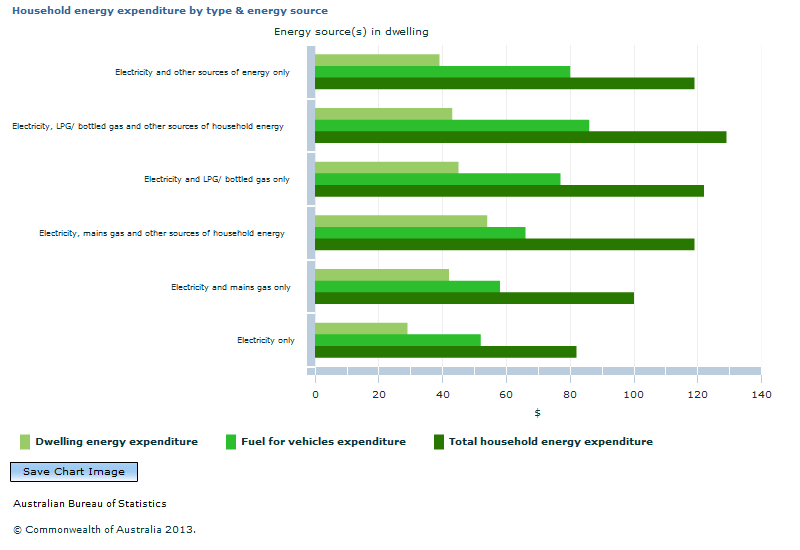4670.0 - Household Energy Consumption Survey, Australia: Summary of Results, 2012
ARCHIVED ISSUE Released at 11:30 AM (CANBERRA TIME) 24/09/2013 First Issue
Page tools:
 Print Page Print Page
 Print All Print All
| ||
|
SUMMARY OF FINDINGS In 2012, Australian households spent an average of $99 per week on energy. This included $39 per week on energy sources used within the dwelling (such as electricity or gas) and $60 for fuel for vehicles. The type and number of energy sources used within a dwelling influenced weekly energy costs. Households with electricity only connected in their dwelling spent the lowest amount on dwelling energy ($29 per week). By comparison, households with multiple energy sources spent significantly more on dwelling energy per week. For instance, households with LPG/ bottled gas and another type of dwelling energy spent $43 per week.  Overall, Australian households' average expenditure on energy represented 5.3% of total gross weekly household income (2.0% for dwelling energy and 3.2% for fuel for vehicles). Among the states and territories, total household energy costs were higher in the Northern Territory ($110 per week) and Australian Capital Territory ($109 per week) than most other states and territories. Queensland had the lowest expenditure on energy for dwellings ($30 per week) compared to all other states and territories while the Northern Territory spent significantly more on fuel for vehicles ($70 per week) than most other states and territories (except Queensland, Western Australia and the ACT where fuel expenditure was not significantly different). .gif) Energy costs for Tasmanian households were the highest when expressed as a proportion of their gross household income. Energy costs represented 6.9% of gross weekly household income for Tasmanian households. By comparison, ACT households had the lowest, with energy costs representing 4.5% of gross household income, significantly lower than for other areas except the Northern Territory and Western Australia. Note that climate zone (or zones) of a state and territory has a large influence on energy expenditure. More information on energy consumption within climate zones can be found in the section on climate zones in this product. The following pages provide additional information on groups and topics of interest around household energy consumption: Economic resources Tenure and landlord type Dwelling characteristics Family composition of household Climate zone Document Selection These documents will be presented in a new window.
|
|
